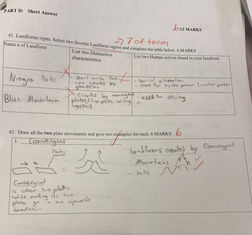Ysabela Reyes | Teacher Candidate
D. Learning Engagements Within Units
This learning outcome focuses on content connection to units from beginning learning engagements to culminating tasks.

Throughout the semester, I had the opportunity to create lesson plans, culiminating tasks such as tests as well as discuss plans for ISUs. In order to build on student response, if I noticed that students were struggling with a concept I would ensure that I would go over the concept again the following learning engagement to make sure they understand the concept before moving onto a new concept. For example, before introducing students to how to read and create their own climographs, they first needed to understand the factors that affect climate in order to be able to explain what they are seeing on climographs. By reviewing and allowing more time for students to understand the multiple factors of climate, they were able to explain their answers more effectively. Whenever I began a new learning engagement, I would use different strategies to assess for learning whether it is oberserving students' conversations in paired or small group activities, discussions, or prompts. I would also offer the opportunity for students to learn from one another through discussions on various topics and they would offer their ideas that they could critique. In my block for example, I decided to wrap up the physical geography and climate unit that was combined into one by doing a final lesson that applied all of their knowledge learned throughout such as how the earth was created, the rock cycle, glaciation, vegetation, climate and weather and how these all impact Canada's landform regions that we currently live on. By wrapping up the unit before the final unit test in this way, students were able to review and test their own knowledge of what they have previous learned, and applied their prior knowledge to give reasoning to how people live across the different regions in Canada.
When making a geography unit test before my block, I noticed that some students did not understand certain concepts I initally belived the students were prepared to answer. Thus, when making the next test during my block, I took note of where the students struggled such as the short answer and long answer questions and made it so that it was more accessible for students of various levels. For students who had IEPs, I made sure to make a separate test that catered to their learning needs, have extra time, write them in the resource room if they wanted a different space and altered some of the questions to help best help them succeed. I realized by making these modifications and having learned from my previous experience of writing a test that the students were able to achieve a higher level of success on the unit test during my block.
I also had the opportunity to discuss with my MT about possible ISU ideas for the students. I offered the suggestion for students to make a video or podcast for the grade 12s in which they could discuss various topics covered throughout the semester to make it fun and interesting. Students could work individually, in pairs or small groups to allow for student voice and choice, as well as giving them the opportunity to come up with their own topics that interest them that connect to the topics covered in the semester. For the grade 9s, my mentor teacher and I discussed that it would be interesting to do a research project/presentation in a format of their choosing on a Canadian city of students' choosing, and they would have to use their knowledge from the semester to describe its physical features, climate, resources, population, industries and human activities as if they were a tour guide promoting the city. In this way, students had the ability to connect what they learned throughout the semester in a fun and meaningful way.
Below are some images and files that demonstrates this learning outcome. Please click on the following content for further details.






